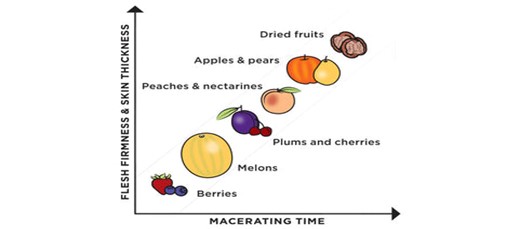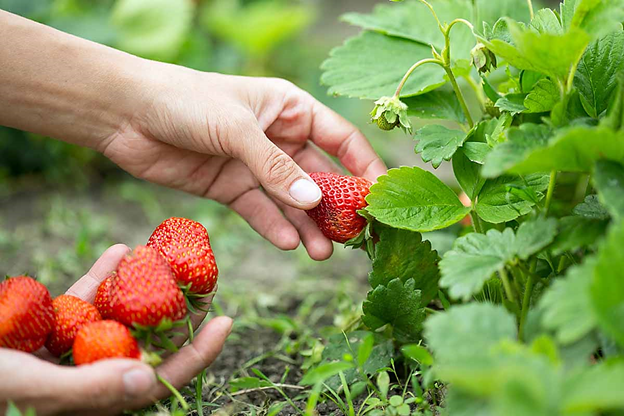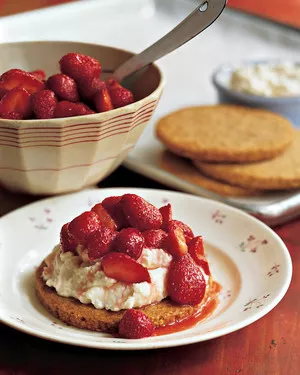Berry Season Is Coming: Time to Sharpen Your Macerating Skills!
While strawberry shortcakes are usually made with a sweet biscuit recipe, have you ever thought about using a yellow or white cake recipe instead? The spongy cake crumb is perfect for soaking up all of the juices from the macerated berries.

And while you’re at it, have you ever thought of making your shortcakes in a muffin tin? The cup size creates a perfect individual serving size. Just turn the cupped cake upside down and voila!
But shortcake options aren’t what I really want to talk about. My focus is on the “macerated” strawberries, mentioned above. Macerating fruit is a simple technique that involves soaking fruit in a liquid to soften it and bring out its natural flavor. The fruit absorbs the liquid and seasonings, which can change the flavor and texture. Macerating is similar to marinating, but with fruit instead of meat or vegetables.
Macerated strawberries might sound fancy, but the technique is very simple. Here are some tips for macerating fruit in general. The chart below shows approximate soaking times according to which fruit you’re using. (NOTE: strawberries don’t need the heat or the added liquid.)

In a nutshell, macerating can elevate breakfasts and desserts to a whole new level of “Yum!”

It’ll be full-blown strawberry season before we know it, so here’s a recipe to get us ready. This is from www.marthastewart. She says “This is a hands-off recipe: Just toss strawberries with sugar and let time take care of the rest. The sugar will coax out the berries' juices, creating a thick and succulent syrup, while the strawberries will deepen in flavor and soften in texture. The result is a versatile, sweet-tart topping that’s hard to resist.”

1 pound fresh strawberries hulled (halved or quartered if large)
2 tablespoons sugar
Directions:
Add Recipe to Cook'n

And while you’re at it, have you ever thought of making your shortcakes in a muffin tin? The cup size creates a perfect individual serving size. Just turn the cupped cake upside down and voila!
But shortcake options aren’t what I really want to talk about. My focus is on the “macerated” strawberries, mentioned above. Macerating fruit is a simple technique that involves soaking fruit in a liquid to soften it and bring out its natural flavor. The fruit absorbs the liquid and seasonings, which can change the flavor and texture. Macerating is similar to marinating, but with fruit instead of meat or vegetables.
Macerated strawberries might sound fancy, but the technique is very simple. Here are some tips for macerating fruit in general. The chart below shows approximate soaking times according to which fruit you’re using. (NOTE: strawberries don’t need the heat or the added liquid.)

- TAKE TIME: Macerating starts immediately, but the best results take 30 minutes to overnight.
- ADD HEAT: Slightly heating the soaking liquid can speed up the process.
- USE LIQUIDS: You can soak fruit in vinegar, liqueur, wine, fruit juice, or sugar. The acidity in the liquid draws out the natural sugar and juices. Sugar attracts moisture and pulls water out of the fruit, making the fruit softer and creating a syrup.
- SPRINKLE WITH SUGAR: Sugar is hygroscopic, which means it attracts water. Sprinkling sugar strawberries draws out their juices so they become soft and sweet.
- AVOID MUSH: To avoid mushy macerated strawberries, keep the berries whole or cut them into halves or quarters. Thinly sliced strawberries are more likely to become too soft.
In a nutshell, macerating can elevate breakfasts and desserts to a whole new level of “Yum!”

It’ll be full-blown strawberry season before we know it, so here’s a recipe to get us ready. This is from www.marthastewart. She says “This is a hands-off recipe: Just toss strawberries with sugar and let time take care of the rest. The sugar will coax out the berries' juices, creating a thick and succulent syrup, while the strawberries will deepen in flavor and soften in texture. The result is a versatile, sweet-tart topping that’s hard to resist.”
Macerated Strawberries

Ingredients:
1 pound fresh strawberries hulled (halved or quartered if large)
2 tablespoons sugar
Directions:
Let sit at room temperature until juices are released, at least 30 minutes (longer is better).
NOTES:
Macerated strawberries can be refrigerated, covered, up to 1 day.
If you don't have white sugar, you can macerate strawberries with powdered or brown sugar.
To elevate your macerated strawberries, add a pinch of flake salt or sprinkle of lemon juice to intensify the fruit's sweetness. You can also drizzle the strawberries with balsamic vinegar for a tangy twist.
NOTES:
Macerated strawberries can be refrigerated, covered, up to 1 day.
If you don't have white sugar, you can macerate strawberries with powdered or brown sugar.
To elevate your macerated strawberries, add a pinch of flake salt or sprinkle of lemon juice to intensify the fruit's sweetness. You can also drizzle the strawberries with balsamic vinegar for a tangy twist.
Recipe formatted with the Cook'n Recipe Software from DVO Enterprises.
 Alice Osborne
Alice Osborne
DVO Newsletter Contributor since 2006
Email the author! alice@dvo.com
Sources:
- www.feastandfarm.com
- www.affamatanbpt.com
- www.gardenerspath.com
- www.marthastewart.com
